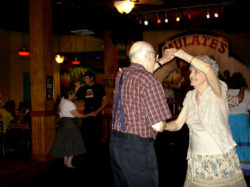Cajun Dance Halls
Cajun dance halls–salles de danse– are live music venues where dancing, courtship, and community building transpire.

Public Domain.
Dancing at Mulate's.
Cajun dance halls—salles de danse—are live music venues where dancing, courtship, and community building transpire. During the late nineteenth and twentieth centuries, these rustic ballrooms resembled wooden warehouses, with a hardwood dance floor and benches lining the walls. The community halls offered entertainment and refreshments, including gumbo, at the week’s end. Before the advent of electricity, acoustic performances by fiddlers and, later, accordion-based ensembles provided entertainment in the ambient glow of kerosene lamps. In more recent years, dance halls offer alcohol and amplified dance music. Once as widespread as parish churches, these institutions now are an endangered part of Louisiana’s cultural landscape.
Evolution of the Salle de Danse
Cajun dance halls first emerged in Louisiana around the time of the Civil War (1861–1865). French travel writer Alexandre Barde maintains that Cajuns congregated in local dance halls as early as 1859. These structures, as travel writer Charles Dudley later described, “had benches along the wall and at one end a high dais for the fiddlers, and a little counter where the gombo [sic] file (the common refreshment) is served.” Wooden shutters served as windows, and alcohol generally was prohibited within the building.
Dancing served as the main vehicle for courtship within the Cajun community. Hence, regimented racial and gender roles dictated these community gatherings. Dances were strictly segregated. While black performers occasionally entertained white audiences, social norms forbade people of color from flirting and engaging in courtship rituals with white women. Chaperones always accompanied unmarried girls. Women congregated along one side of the hall, away from the unmarried men who were also their potential suitors, and remained inside the building for the duration of the dance. Young men, on the other hand, remained in a designated staging area dubbed the “bull pen” or la cage aux chiens (dog cage) when not dancing. Unlike women, they could retire freely outside the hall, where married men often loitered, drank alcohol, smoked, and visited with their family and neighbors.
Dances were family affairs, with small children brought along by their mothers. As late as the 1930s, women maintained a kind of child care center in an interior room of the dance hall that housed one or two beds. Young children could sleep in this parc aux petits (literally “children’s park”) as their parents danced or chaperoned their siblings. Parc aux petits gave way to the moniker fais do do (literally “go to sleep”), used by twentieth-century Cajun elites to emphasize the quaintness of dance culture and hide the darker side of dance hall culture.
Before the Civil War, house dances were, by all accounts, peaceful affairs. But when the war introduced a new culture of violence, emergent salles de danse became deadly. Fisticuffs, knives, and gunplay became common and widespread. During the first half of the twentieth century, local newspaper headlines ranged from the general—“Youth Is Stabbed At Country Dance” and “Killed At Sunday Ball”—to more specific descriptions such as “Youth Shoots Down Three Brothers At Country Ball In Evangeline On Easter.” Fights erupted as a result of ongoing feuds, public drunkenness, and even courtship competition. Violence continued well after midcentury, with the rise of honky-tonks throughout the South.
The Modern Dance Hall
Dancing changed over time in accordance with contemporary trends in Cajun and American popular music, both of which were played in dance halls. Turn-of-the-twentieth-century couple dances, including waltzes, polkas, mazurkas, two-steps, quadrilles, lanciers, contradanses, jigs, and valse à deux temps faded from popularity by the 1920s. Popular American dances such as the Charleston, Big Apple, and Jitterbug kept Cajuns in step with the rest of the country. For instance, civic centers in Eunice, Opelousas, and Rayne held local Charleston dance contests in 1926, at the very peak of the dance’s popularity.
Meanwhile, other aspects of dance halls also changed with the times. After World War II, Cajun dance halls became less family oriented. Refreshment stands, typically located at the entrance and distinguished from the dance floor by a partition, began serving alcohol. A gambling room replaced the traditional parc aux petits. Married men often retired to these cramped back rooms to drink, smoke cigarettes, and play cards. Proprietors installed jukeboxes for nights without live music or to fill in when a band took a break. Tables replaced the long benches formerly outlining the dance floor. The introduction of electricity brought large electric fans to circulate air inside the perpetually stuffy dance halls.
In 1980, a new type of venue emerged when Mulate’s, a combined restaurant-dance hall, opened in Breaux Bridge, retaining some measure of a family-oriented venue. Other restaurant-dance halls, including Prejean’s and Randol’s in Lafayette, quickly followed suit, capitalizing on this new niche market and the national Cajun culinary craze of the 1980s. In the twenty-first century, traditional dance halls no longer occupy the central place the once did.
